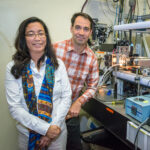A team that included Banumathi Sankaran of the Molecular Biophysics and Integrated Bioimaging Division studied a protein called σNS, an important component of some viral factories. Understanding how this protein works will foster development of therapeutic strategies against viruses that use similar proteins to replicate.
Towards a New Framework for Radiation Cancer Treatment
Though it may seem counterintuitive, delivering ultrafast, high-intensity doses of radiation to tumors can actually reduce the toxicity to surrounding healthy cells, while still directing a potent anti-cancer effect towards the target. Scientists have documented this perplexing phenomenon—dubbed the FLASH radiotherapy effect—in both cell lines and animal models, but they have yet to confirm how or why it works. A new experimental platform that uses X-rays to investigate the FLASH effect brings science a step closer to clarifying its underlying mechanisms, laying the foundation for major strides in the field of radiation oncology.
Hura, Tsutakawa named Science Deputy, Structural Biology Department Head
Molecular Biophysics and Integrated Bioimaging (MBIB) Division Director Junko Yano has announced that staff scientists Greg Hura and Susan Tsutakawa have officially assumed the roles of MBIB Science Deputy and Head of the Structural Biology Department, respectively. They have been serving in these positions on an interim basis since August 2021.
Biosciences Researchers Launching Biopreparedness Projects
Two scientists in the Area, Greg Hura and Vivek Mutalik, are heading up research projects that are part of the Department of Energy’s Biopreparedness Research Virtual Environment (BRaVE) initiative. Yasuo Yoshikuni, a scientist at the Joint Genome Institute, is part of a third project that is being led by Brookhaven National Laboratory. These projects will leverage bioimaging expertise to develop better therapies and vaccines for viruses, develop a high-throughput platform to rapidly design countermeasures to drug-resistant pathogens, and unlock the molecular basis of plant-pathogen interactions to create resilient bioenergy crops.
A New Pathway for Clearing Misfolded Proteins
Stanford researchers have used cryogenic 3D imaging at the National Center for X-ray Tomography (NCXT) to identify a new pathway for clearing misfolded proteins from cells. This work presents a potential therapy target for age-related disorders like Alzheimer, Parkinson, and Huntington Diseases.
- 1
- 2
- 3
- …
- 17
- Next Page »
Was this page useful?








